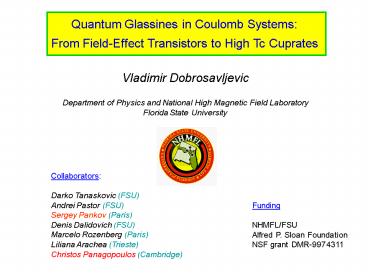Quantum Glassines in Coulomb Systems: - PowerPoint PPT Presentation
1 / 20
Title:
Quantum Glassines in Coulomb Systems:
Description:
Quantum Glassines in Coulomb Systems: From Field-Effect Transistors ... (undress the electrons)... ...to reveal the low-temperature. normal-state phase diagram ... – PowerPoint PPT presentation
Number of Views:74
Avg rating:3.0/5.0
Title: Quantum Glassines in Coulomb Systems:
1
Quantum Glassines in Coulomb Systems From
Field-Effect Transistors to High Tc Cuprates
Vladimir Dobrosavljevic Department of Physics
and National High Magnetic Field
Laboratory Florida State University
Collaborators Darko Tanaskovic (FSU) Andrei
Pastor (FSU) Sergey Pankov (Paris) Denis
Dalidovich (FSU) Marcelo Rozenberg
(Paris) Liliana Arachea (Trieste) Christos
Panagopoulos (Cambridge)
Funding NHMFL/FSU Alfred P. Sloan Foundation NSF
grant DMR-9974311
2
Prologue
The sad story of the farmer and his silos
Sometimes the ENTIRE SILOS simply
explodes!!! (catastrophic avalanches -
fluctuation on the scale of the system)
3
Large fluctuations critical states of matter
critical
super-critical
sub-critical
Large fluctuations (critical opalescence) only
near the critical point only
Why are the fractals so common???!!!
4
Contents
- Dirty conductors/insulators electron glasses
- What is known Coulomb gap, glassiness, no
screening? - Long-range Coulomb interactions self-organized
criticality at T0 - Quantum melting of electron glass Anderson vs.
Mott localization - Glassiness as key to High Tc superconducitvity?
5
Glassy behavior of disordered electrons?
6
What is known about the Coulomb glass?
7
Coulomb Glass Model
Efros-Shklovskii theory r(e)
Cd(e-eF)d-1 (Bound !!) NOTE in ALL dimensions!!!
T0
Experiment tunneling spectra of SiB (Mark Lee,
Phys. Rev. Lett. 93, 256401 (2004))
Powerlaw behavior at low energy critical state?
8
- Open questions
- Why is the bound saturated?
- Why universal prefactor and exponent?
- Relation to possible glassy freezing
- ES assumed no screening. Why?
- Role of quantum fluctuations, MIT?
9
EDMFT approach controlled theory in large d A.
A. Pastor and V. Dobrosavljevic, PRL 83, 4642
(1999)
Physical content environment (cavity)
treated in a Gaussian approximation. (quasiparti
clesplasmons)
10
Simulation (T. Vojta, 1995)
Approaching the Coulomb Glass Pseudogap Phase
Theory
At stronger disorder, the plasma dip disappears!
NO adjustable parameters!!!
11
Exotic Features of the Electron Glass Phase
12
What about the Efros-Shklovskii gap?
Efros-Sklovskii theory r(e)
Cd(e-eF)d-1 Gap EG W-1/(d-1)
EG
- Our analytical results give TG W-1/(d-1) (at W
large) - This suggests that the universal Coulomb gap
- is a feature of the glassy phase.
- Consistent with vanishing ZFC compressibility
- at T0 in the glass phase, thus no screening
- recent extension of our approach (Muller and
Ioffe, 2004) - explicitly show that lscr 1/T. Thus zeff ??
MFT valid!!!
13
Quantum Melting of the Electron Glass
Glassy behavior deep in the insulator
(EfrosShklovskii, Pollak) Question when does
the glass melt?
Mobile electrons quantum
fluctuations MELT glass at T0
E-DMFT replica symmetry breaking (Parisi-like
scheme)
Diverges at Anderson-like transition Vanishes at
Mott transition
14
Global Phase Diagram DMFT picture of the
Metal-Insulator Transition Dobrosavljevic,
Tanaskovic, Pastor PRL 90, 016402 (2003)
- Metallic glass phase
- Hierarchical,
- correlated dynamics
- (scale invariant)
- Experiments by
- Popovic et al., PRL 2002
- Kar et al., PRL 2003
- Replicon modes
- Non-Fermi liquid
- transport (a la Sachdev)
- Dalidovich and Dobrosavljevic, PRB (2002)
Metal
Metallic Glass
Wigner-Mott Glass (gapless)
Wigner-Mott Solid (incompressible)
Disorder
WU
15
Glassy behavior as key to high-Tc
superconductors?(C. Panagopoulos,
V.Dobrosavljevic, cond-mat/0410111)
16
Resistivity of a high Tcsuperconductor
Puzzling Marginal Fermi Liquid behavior
(Takagi, 92)
17
Glassy behavior and superconductivity?(C.
Panagopoulos et al.)
Standard spin-glass signatures at low doping
muSR data within the superconducting
phase glassiness persists!!!
spin and charge correlation!
18
The Abnormal Normal State of the High-Tc
Superconductors
Using 60 teslas ... ...to suppress the
superconducting state ...(undress the
electrons) to reveal the low-temperature
normal-state phase diagram
19
Phase diagram
- STM imaging evidence of
- an inhomogeneous state!
- (Takagi, PRL 2004).
- THEORY
- Nano-scale phase separation
- Gorkov and Sokol 87, Kivelson, Dagotto et al
- Self-generated stripe glass
- Schmalian and Wolyness (EDMFT-2000)
- Charge tunneling gives logT
- Efetov, PRL 2003
SC glass
glassy insulator
inhomogeneous (glassy) metal
homogeneous metal
20
Conclusions What have we learned from the EDMFT
approach to the Coulomb glass?
- Coulomb repulsion disorder glassiness
- Absence of screening (at T0) in the glassy
phase - Self-organized criticality, marginal stability ?
universal Coulomb gap - Quantum fluctuations due to mobility of
electrons - Anderson localization singular perturbation,
stabilizes glass - Intermediate metallic glass phase as seen in
MOSFETs - Possible key role in MOSFETs, high Tc
superconductors,...































